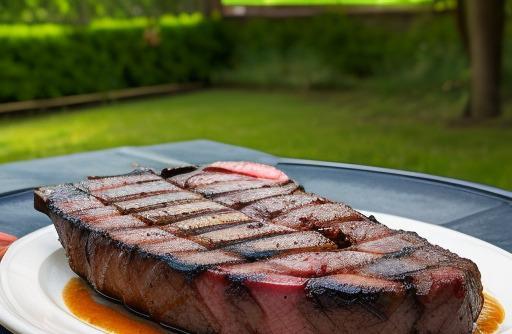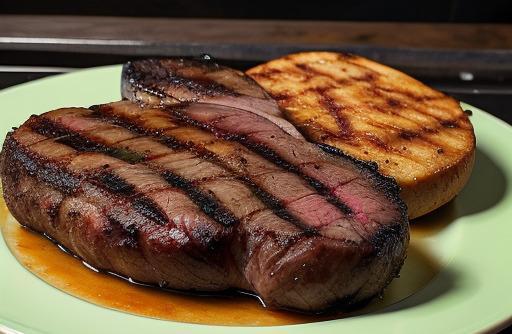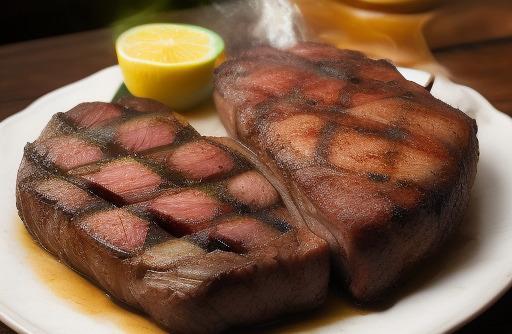- You are here:
- Home »
- Food Substitutes
- » Best Substitutes For Red Meat
Best Substitutes For Red Meat

Red meat has long been a staple for many individuals, providing a rich source of protein and essential nutrients. However, due to various reasons such as personal preference, health concerns, or dietary restrictions, some people opt for alternatives to red meat. Luckily, there are several excellent substitutes available that can provide similar nutritional benefits and flavors. In this article, we will explore the best substitutes for red meat, their benefits, and tips on using them in your cooking.
Key Takeaways
- Red meat substitutes offer a range of health benefits, such as reduced saturated fat and cholesterol levels.
- Plant-based alternatives can be an excellent source of protein, iron, and other essential nutrients.
- Various vegetarian and vegan options provide similar flavors, textures, and cooking versatility as red meat.
- Experimenting with different substitutes can add diversity and excitement to your meals.
Why You Need A Substitute For Red Meat
There are several reasons why individuals might seek alternatives to red meat:
-
Health Concerns: Red meat, when consumed in large quantities, has been associated with an increased risk of heart disease, certain cancers, and other health conditions. By opting for substitutes, you can decrease your intake of saturated fat and cholesterol while still meeting your protein needs.
-
Personal Preference: Some individuals simply prefer the taste and texture of plant-based alternatives or find ethical reasons not to consume animal products.
-
Dietary Restrictions: For individuals following vegetarian or vegan diets, as well as those with religious or cultural dietary restrictions, red meat alternatives play an important role in providing necessary nutrients.
By incorporating substitutes for red meat into your diet, you can address these concerns and enjoy the benefits they offer.
Types Of Substitutes For Red Meat

When it comes to finding suitable alternatives for red meat, there are several options available:
-
Plant-based Proteins: These include beans, legumes (such as lentils and chickpeas), tofu, tempeh, and seitan. These alternatives are rich in protein, fiber, and various vitamins and minerals.
-
Other Animal Proteins: Poultry, fish, and seafood can also be considered as substitutes for red meat. While they are still animal-derived, they generally have lower levels of saturated fat and cholesterol.
-
Meat Analogues: These products are specifically designed to mimic the taste, texture, and appearance of red meat. They are often made from a combination of plant protein sources and can be found in the form of burgers, sausages, and meatballs.
Each type of substitute offers its own unique benefits and can be used in a variety of ways to suit different tastes and dietary needs.
Best Substitutes For Red Meat

-
Beans and Legumes: Beans and legumes are an excellent source of protein and fiber, making them a nutritious substitute for red meat. They are versatile and can be used in various dishes like curries, stews, and salads. Lentils, chickpeas, black beans, and kidney beans are great options to incorporate into your meals.
-
Tofu: Tofu, made from soybeans, is a popular plant-based protein source. It has a neutral flavor and can absorb the flavors of the dish it is cooked in, making it incredibly versatile. Tofu can be grilled, stir-fried, or added to soups and stews to provide a meaty texture.
-
Tempeh: Another soy-based product, tempeh offers a nutty flavor and a firm texture. It is made by fermenting soybeans, which enhances its nutrient profile. Tempeh can be marinated, grilled, or crumbled and used in dishes such as tacos, stir-fries, and sandwiches.
-
Seitan: Seitan, also known as wheat meat, is a popular option for those seeking a meat-like texture. It is made by washing wheat flour dough to remove the starch, resulting in a high-protein product. Seitan can be seasoned, grilled, or sautéed to create a meaty texture and is often used in dishes like stir-fries and stews.
-
Poultry: If you are looking for alternative meat options, poultry such as chicken and turkey can be great substitutes for red meat. They are leaner and lower in saturated fat. Poultry can be grilled, roasted, or added to a variety of dishes like salads and stir-fries.
-
Fish and Seafood: Fish and seafood provide an excellent source of lean protein and omega-3 fatty acids. Options like salmon, tuna, and shrimp can be used in place of red meat in dishes like tacos, pasta, and sandwiches.
-
Meat Analogues: There are a variety of commercially available meat analogues that closely resemble the taste and texture of red meat. These can be a convenient option when you crave the familiar taste of meat. Look for plant-based burgers, sausages, and meatballs made from ingredients like soy, pea protein, or mushrooms.
Choosing The Right Substitute For Red Meat

When choosing a substitute for red meat, there are a few factors to consider:
-
Nutritional Profile: Look for substitutes that provide a good balance of protein, healthy fats, and essential vitamins and minerals. Consider options that have a similar nutrient profile to red meat to ensure you are still meeting your dietary needs.
-
Flavor and Texture: Consider whether you want a substitute that closely mimics the taste and texture of red meat or one that offers a distinct flavor of its own. Experiment with different options to find substitutes that align with your preferences.
-
Cooking Versatility: Consider how versatile the substitute is in terms of cooking methods and the variety of dishes it can be used in. Some substitutes may work better for grilling, while others may excel in stews or stir-fries. Choose substitutes that can be easily incorporated into your favorite recipes.
-
Dietary Restrictions: If you have specific dietary restrictions, such as being vegan or gluten-free, make sure to choose substitutes that align with your needs.
By considering these factors, you can select the right substitute for red meat that suits your taste, dietary requirements, and cooking preferences.
Cooking With Substitutes For Red Meat

Cooking with substitutes for red meat can be an enjoyable and creative experience. Here are some tips to make the most of your substitutes:
-
Marinating: Marinating tofu, tempeh, or seitan can enhance their flavors and textures. Use a mixture of herbs, spices, and sauces to infuse the substitute with delicious flavors.
-
Spices and Seasonings: Experiment with different spices and seasonings to bring out the best flavors in your substitutes. Use combinations of herbs, spices, and sauces that complement your chosen substitute.
-
Texture Enhancement: If you prefer a more meat-like texture, try techniques such as crumbling tempeh for a ground meat substitute or grilling tofu or seitan for a firmer texture.
-
Combining Substitutes: Don’t be afraid to mix and match different substitutes for added variety and complexity. Combining tofu and tempeh, for example, can provide a unique texture and flavor profile to your dish.
-
Recipe Adaptation: Look for recipes that specifically use your chosen substitute. Many vegetarian and vegan cookbooks and websites offer a wide range of recipes that utilize plant-based proteins in creative and exciting ways.
-
Pro Tip: When cooking with tofu, press it beforehand. Place the tofu between two plates and put some weight on top (such as a heavy book) to remove excess moisture. Pressing tofu improves its texture and allows it to absorb flavors more effectively.
By exploring different cooking techniques and flavors, you can make your substitutes for red meat delicious and satisfying.
Recipes Using Substitutes For Red Meat

Here are a few recipe ideas to inspire you in using substitutes for red meat:
-
Vegetarian Chili: Replace ground beef with a combination of kidney beans, lentils, and mushrooms for a hearty and flavorful vegetarian chili. Add your favorite spices, vegetables, and tomato sauce for a delicious meal.
-
Tofu Stir-Fry: Marinate tofu in a mixture of soy sauce, ginger, garlic, and sesame oil, then stir-fry it with an assortment of colorful vegetables for a quick and nutritious meal. Serve over steamed rice or noodles.
-
Lentil Bolognese: Replace ground beef with cooked lentils in your favorite pasta sauce recipe. The lentils provide a meaty texture and soak up the flavors of the sauce. Serve over spaghetti or your preferred pasta shape.
-
Seitan Fajitas: Marinate sliced seitan in a blend of lime juice, chili powder, cumin, and garlic. Sauté onions and bell peppers alongside the marinated seitan and serve with warm tortillas, salsa, and guacamole.
-
Chickpea Burgers: Mash cooked chickpeas and mix them with breadcrumbs, spices, and chopped vegetables like onions and peppers. Form the mixture into patties and grill or pan-fry for a delicious vegetarian burger.
These recipes are just a starting point. Feel free to get creative and adapt them to suit your taste preferences and the substitutes you choose.
Storage And Shelf Life Of Substitutes
The storage and shelf life of red meat substitutes may vary depending on the type:
-
Beans and legumes: Dried beans and legumes can be stored in a cool, dry place for up to one year. Once cooked, they can be refrigerated for up to five days.
-
Tofu: Unopened packages of tofu can be stored in the refrigerator for up to one week. Once opened, they should be consumed within a few days. To extend the shelf life, tofu can be frozen for up to five months.
-
Tempeh: Unopened packages of tempeh can be stored in the refrigerator for up to two weeks. Once opened, it should be consumed within a few days. Tempeh can also be frozen for up to six months.
-
Seitan: Seitan can be refrigerated for up to one week. It freezes well and can be stored for three to four months in the freezer.
-
Poultry, fish, and seafood: These should be stored in the refrigerator and consumed within a few days. Freezing can extend their shelf life by several months.
-
Meat analogues: Follow the storage instructions provided on the packaging. Most meat analogues can be stored in the freezer for several months.
Always check the packaging or consult specific recipes for proper storage instructions to maximize the freshness and shelf life of your chosen substitutes.
Conclusion
Whether you have health concerns, dietary restrictions, or personal preferences, finding suitable substitutes for red meat can provide you with a range of benefits. From plant-based proteins to poultry, fish, and meat analogues, there are numerous options available. By choosing the right substitute, experimenting with different flavors and cooking techniques, and exploring various recipes, you can enjoy delicious and nutritious meals without compromising on taste or health. Incorporate these substitutes into your diet and discover the exciting world of meat alternatives while reaping the rewards of a balanced and diverse culinary experience.
FAQS
What Are The Best Substitutes For Red Meat For Vegetarians?
Some of the best substitutes for red meat for vegetarians include tofu, tempeh, seitan, legumes, and mushrooms. These foods are a great source of protein, vitamins, minerals, and fiber and can be used in a variety of recipes to replace red meat.
What Are Some Good Substitutes For Red Meat For Those Looking To Reduce Their Consumption?
If you’re looking to reduce your consumption of red meat, some great substitutes include chicken, seafood, eggs, dairy products, and plant-based protein powders. These foods are low in saturated fat and cholesterol and can help you meet your daily protein requirements.
What Are The Health Benefits Of Using Substitutes For Red Meat In Your Diet?
There are several health benefits to using substitutes for red meat in your diet. Plant-based proteins are generally lower in saturated fat and cholesterol, which can help reduce your risk of heart disease, stroke, and high blood pressure. Additionally, these foods are high in fiber, vitamins, and minerals, which can promote overall health and well-being.
What Are Some Easy Recipes That Use Substitutes For Red Meat?
There are countless recipes that use substitutes for red meat, including stir-fries, tacos, salads, soups, and stews. Some easy recipes include lentil soup, tofu stir-fry, mushroom risotto, black bean tacos, and chickpea curry. There are also many delicious plant-based burger and meatball recipes available online.
Are There Any Downsides To Using Substitutes For Red Meat In Your Diet?
While substitutes for red meat can be a healthy addition to your diet, it’s important to note that not all meat substitutes are created equal. Many processed meat alternatives are high in sodium, preservatives, and artificial flavorings, which can be detrimental to your health. Additionally, some people may experience digestive issues if they consume too much plant-based protein. It’s important to choose whole food sources of protein whenever possible and to speak with a nutritionist if you have any concerns.
Sources
About the Author Jenny
I'm Jenny, a housewife with an unwavering passion for food. My culinary journey began with my grandmother's kitchen, and it's now a full-fledged food blog. I've turned my love for cooking into a creative outlet, sharing recipes and stories with a global community of fellow food enthusiasts. It's proof that being a housewife can also mean pursuing your passions and savoring life's delectable moments.
